
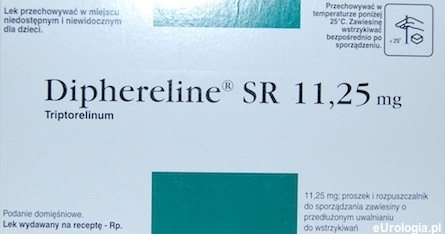
Diphereline Sr 11,25 mg

Ask a doctor about a prescription for Diphereline Sr 11,25 mg

How to use Diphereline Sr 11,25 mg
Leaflet accompanying the packaging: information for the user
Diphereline SR 11.25 mg
11.25 mg
Powder and solvent for prolonged-release suspension for injection
Triptorelinum
Read the leaflet carefully before using the medicine, as it contains important information for the patient.
- Keep this leaflet, you may need to read it again.
- In case of any doubts, consult a doctor or pharmacist.
- This medicine has been prescribed specifically for you. Do not pass it on to others. The medicine may harm another person, even if their symptoms are the same.
- If the patient experiences any side effects, including any side effects not listed in this leaflet, they should tell their doctor or pharmacist. See section 4.
Table of contents of the leaflet
- 1. What is Diphereline SR 11.25 mg and what is it used for
- 2. Important information before using Diphereline SR 11.25 mg
- 3. How to use Diphereline SR 11.25 mg
- 4. Possible side effects
- 5. How to store Diphereline SR 11.25 mg
- 6. Contents of the packaging and other information
1. What is Diphereline SR 11.25 mg and what is it used for
This medicine contains triptorelin. Triptorelin belongs to a group of medicines known as gonadotropin-releasing hormone (GnRH) analogues. One of its actions is to reduce the production of sex hormones in the body.
Long-term administration of triptorelin, after initial stimulation, causes inhibition of gonadotropin secretion, which in turn leads to inhibition of gonadal function (testes and ovaries).
The medicine is used:
- In the treatment of prostate cancer. Treatment of prostate cancer when a reduction in testosterone levels to castration levels is required. Patients who have not been treated with hormone therapy respond better to treatment with triptorelin.
- In children for the treatment of precocious puberty, which occurs at a very early age, i.e. before the age of 8 in girls and before the age of 10 in boys (central precocious puberty).
2. Important information before using Diphereline SR 11.25 mg
When not to use Diphereline SR 11.25 mg
- If the patient is allergic to triptorelin, gonadorelin (GnRH), other GnRH analogues or any of the other ingredients of Diphereline SR 11.25 mg,
- During pregnancy and breastfeeding.
Warnings and precautions
Before starting treatment with Diphereline SR 11.25 mg, discuss it with your doctor or pharmacist.
Patients receiving this medicine should be under close medical supervision with regular monitoring of biochemical parameters, clinical and radiological monitoring if necessary.
There have been reports of depression, including severe depression, in patients taking Diphereline SR 11.25 mg. If depressive moods occur during treatment with Diphereline SR 11.25 mg, the doctor should be informed.
In the case of anticoagulant therapy, bruising may occur at the injection site. The medicine can only be administered intramuscularly or subcutaneously in men.
In adults, long-term treatment with triptorelin may cause bone weakening (osteoporosis) associated with an increased risk of bone fractures. The doctor should be informed if the patient has any of the following risk factors, as the doctor may recommend the use of bisphosphonates (medicines used to treat osteoporosis) to treat bone mass loss.
Risk factors may include:
- Osteoporosis in the patient or their immediate family;
- Alcohol abuse, smoking, malnutrition;
- Long-term use of medicines that may cause bone mass loss, such as those used to treat epilepsy or corticosteroids (such as hydrocortisone, prednisolone).
During treatment with Diphereline SR 11.25 mg, a pituitary tumour (benign tumour) may become apparent, which the patient was not aware of. Symptoms include sudden headache, vomiting, vision disturbances and eye muscle paralysis.
If seizures occur, the doctor should be informed immediately. Seizures have been reported in patients taking triptorelin or similar medicines. They occurred in patients with previously diagnosed epilepsy and without it.
Men
At the beginning of treatment, an increased level of testosterone in the body may be observed. This may cause an exacerbation of symptoms related to the tumour. In such a case, the doctor should be consulted. The doctor may recommend an additional medicine (anti-androgen) to prevent the exacerbation of these symptoms.
If the patient has urinary tract obstruction or spinal cord compression due to tumour spread, the doctor will closely monitor the patient during the first few weeks of treatment. In case of difficulty urinating, bone pain, lower limb weakness or numbness, the doctor should be consulted immediately, who will assess the patient's condition and initiate appropriate treatment.
Triptorelin does not induce further reduction in testosterone levels in patients after orchiectomy (testicle removal).
The results of diagnostic tests of gonadal pituitary and reproductive organ function performed during or after treatment with Diphereline SR 11.25 mg may be misleading.
The doctor should be informed if the patient has heart or blood vessel disease, including arrhythmias or if the patient is taking medicines used to treat arrhythmias. The risk of arrhythmias may be increased during treatment with Diphereline SR 11.25 mg.
The doctor should be informed if the patient has diabetes and/or heart disease.
Medicines that lower testosterone levels may cause changes in the ECG related to arrhythmias (prolongation of the QT interval).
Children
In girls with precocious puberty, vaginal bleeding may occur in the first month of treatment.
The doctor should be informed if the patient has a progressive brain tumour. This may affect the doctor's decision on the treatment method.
After stopping treatment with Diphereline SR 11.25 mg, the patient will experience symptoms of puberty.
In girls, menstruation usually occurred about a year after stopping treatment.
The doctor should rule out the possibility that precocious puberty is caused by other diseases.
The amount of minerals in the bones decreases during treatment, but returns to normal values after its discontinuation.
After stopping treatment, a hip joint disorder (juvenile epiphyseal separation) may occur, causing stiffness, laxity and/or severe pain in the groin radiating to the thigh. In such a case, a doctor should be consulted.
If a child experiences severe or recurrent headaches, vision problems and ringing or buzzing in the ears, they should contact a doctor immediately (see section 4).
In case of concerns related to the situations described above, a doctor should be consulted.
Diphereline SR 11.25 mg and other medicines
Tell your doctor or pharmacist about all medicines you are currently taking or have recently taken, as well as any medicines you plan to take.
Men:
Diphereline SR 11.25 mg may affect the action of other medicines used to treat arrhythmias (e.g. quinidine, procainamide, amiodarone, sotalol) or may increase the risk of arrhythmias when taken with other medicines (e.g. methadone used to treat pain and as a component of detoxification in the case of drug addiction), moxifloxacin (antibiotic), antipsychotic medicines (used to treat severe mental illnesses).
Pregnancy and breastfeeding
This medicine must not be used during pregnancy and breastfeeding.
Driving and using machines
During treatment, dizziness, fatigue or vision problems, such as blurred vision, may occur. These symptoms may be side effects of treatment or result from the underlying disease. If any of these side effects occur, do not drive or operate any machines.
Diphereline SR 11.25 mg contains sodium
The medicine contains less than 1 mmol (23 mg) of sodium per dose, i.e. the medicine is considered "sodium-free".
3. How to use Diphereline SR 11.25 mg
One injection of the prolonged-release medicine every 3 months.
Method of administration
- In MEN: intramuscular or subcutaneous injection.
- In CHILDREN: only intramuscular injection.
The medicine will be administered by a doctor or nurse.
Do not stop treatment without consulting a doctor.
Using a higher dose of Diphereline SR 11.25 mg than recommended
In case of overdose, symptomatic treatment is recommended.
4. Possible side effects
Like all medicines, Diphereline SR 11.25 mg can cause side effects, although not everybody gets them.
In rare cases, a severe allergic reaction may occur. If symptoms such as difficulty swallowing or breathing, swelling of the lips, face, throat or tongue, rash or dizziness occur, a doctor should be notified immediately.
Men
Many of the side effects are likely to be caused by the change in testosterone levels in the body. These effects include: hot flashes, impotence and decreased libido.
Very common- side effects that occur in more than 1 in 10 patients:
- Hot flashes
- Weakness
- Intensive sweating
- Back pain
- Feeling of tingling in the lower limbs
- Decreased sexual desire
- Impotence
Common–side effects that occur in no more than 1 in 10 patients:
- Nausea, dry mouth
- Pain, bruising, redness and swelling at the injection site
- Muscle and bone pain, pain in arms and legs, swelling (fluid accumulation in tissues)
- Abdominal pain
- High blood pressure
- Allergic reaction
- Weight gain
- Dizziness, headache
- Loss of sexual desire, depression, mood changes
Uncommon–side effects that occur in no more than 1 in 100 patients:
- Increased platelet count
- Feeling of heartbeat
- Tinnitus, dizziness, blurred vision
- Abdominal pain, constipation, diarrhoea, vomiting
- Numness, chills, drowsiness, pain
- Changes in the results of some tests (including increased liver function parameters), high blood pressure
- Weight loss
- Loss of appetite, increased appetite, gout (severe pain and swelling of joints, most commonly affecting the big toe), diabetes, high levels of fats in the blood
- Joint pain, muscle cramps, muscle weakness, muscle pain and tenderness and stiffness
- Tingling and numbness
- Sleep disorders, irritability
- Breast enlargement in men, breast pain (breast tenderness), decreased testicle size, testicle pain
- Shortness of breath
- Acne, hair loss, itching, rash, redness of the skin, hives
- Frequent urination at night, urination disorders
- Nosebleeds
Rare– side effects that occur in no more than 1 in 1000 patients
- Red or purple skin discoloration
- Abnormal sensations in the eye, blurred or disturbed vision
- Feeling of fullness in the abdominal cavity, bloating, taste disturbances
- Chest pain
- Difficulty standing
- Flu-like symptoms, fever
- Severe allergic reaction (anaphylactic reaction), which can cause dizziness or breathing difficulties, swelling of the face or throat
- Rhinitis, pharyngitis
- Joint stiffness, joint swelling, musculoskeletal stiffness, arthritis
- Memory loss
- Feeling of confusion, decreased activity, excitement
- Shortness of breath when lying down
- Blisters on the skin
- Low blood pressure
Side effects reported after the medicine was placed on the market (frequency not known):
- Severe allergic reaction causing swelling of the face, tongue and throat, dizziness or breathing difficulties (Quincke's oedema, anaphylactic shock)
- General malaise, anxiety
- Urinary incontinence
- Changes in the ECG (prolongation of the QT interval)
- In the case of an existing pituitary tumour, increased risk of bleeding into the pituitary
Similar to other GnRH analogues, in patients treated with Diphereline SR 11.25 mg, an increase in white blood cell count may be observed.
In patients receiving long-term treatment with a GnRH analogue in combination with radiotherapy, more side effects may occur, mainly gastrointestinal and related to radiotherapy.
Children
Very common–side effects that occur in more than 1 in 10 patients
- In girls, vaginal bleeding may occur in the first month of treatment
Common–side effects that occur in no more than 1 in 10 patients
- Abdominal pain
- Pain, bruising
- Redness and swelling at the injection site
- Headache
- Hot flashes
- Weight gain
- Acne
- Allergic reactions
Uncommon–side effects that occur in no more than 1 in 100 patients
- Blurred vision
- Vomiting, constipation, nausea
- General feeling of discomfort
- Obesity
- Neck pain, chest pain
- Mood changes
- Nosebleeds
- Itching, rash or hives on the skin
A long-term study (lasting up to 4 years) did not provide any new and significant safety data.
Side effects reported after the medicine was placed on the market (frequency not known):
- High blood pressure
- Seizures
- Abnormal vision
- Severe allergic reaction causing swelling of the face, tongue and throat, dizziness or breathing difficulties (Quincke's oedema, anaphylactic shock)
- Changes in some blood test results, including hormone levels
- Muscle pain
- Mood disorders, depression, nervousness
- Idiopathic intracranial hypertension (increased pressure inside the skull around the brain, characterized by headache, double vision and other vision disturbances and ringing or buzzing in the ears)
Reporting side effects
If you experience any side effects, including any side effects not listed in this leaflet, you should tell your doctor or pharmacist, or nurse. Side effects can be reported directly to the Department of Adverse Reaction Monitoring of Medicinal Products, Medical Devices and Biocidal Products
Al. Jerozolimskie 181C
02-222 Warsaw
Phone: +48 22 49 21 301
Fax: +48 22 49 21 309
Website: https://smz.ezdrowie.gov.pl
Side effects can also be reported to the marketing authorization holder.
By reporting side effects, you can help provide more information on the safety of this medicine.
5. How to store Diphereline SR 11.25 mg
Keep the medicine out of the sight and reach of children.
Do not use this medicine after the expiry date stated on the packaging. The expiry date refers to the last day of the month stated.
Expiry date (EXP)
Batch number (Lot)
Store in a temperature below 25°C.
Use the suspension for injection immediately after preparation.
6. Contents of the packaging and other information
What Diphereline SR 11.25 mg contains
The active substance of the medicine is triptorelin in the form of triptorelin pamoate. One vial contains 11.25 mg of triptorelin.
The other ingredients are:
- The vial with powder contains lactide-co-glycolide polymer, mannitol, sodium carmellose, polysorbate 80
- The ampoule with solvent contains mannitol, water for injections.
What Diphereline SR 11.25 mg looks like and contents of the pack
Powder and solvent for prolonged-release suspension for injection
Vial with powder and ampoule with solvent.
The box contains 1 vial with powder, 1 ampoule with solvent, 1 syringe (made of polypropylene) and 3 needles.
Marketing authorization holder and manufacturer
Marketing authorization holder
Ipsen Pharma
65 Quai Georges Gorse
92100 Boulogne Billancourt
France
Manufacturer
Ipsen Pharma Biotech
Parc d’Activités du Plateau de Signes
Chemin départemental nr 402
83870 Signes
France
To obtain more detailed information about this medicine, please contact the local representative of the marketing authorization holder:
Ipsen Poland Sp. z o.o.
ul. Chmielna 73
00-801 Warsaw
phone: 22 653 68 00
fax: 22 653 68 22
Date of last revision of the leaflet:October 2024
<-------------------------------------------------------------------------------------------------------------------------
Information intended for healthcare professionals only:
Dosage and method of administration
Prostate cancer
One intramuscular or subcutaneous injection of the prolonged-release preparation every 3 months.
In patients with prostate cancer with metastases resistant to castration, not eligible for surgical treatment, receiving triptorelin and eligible for treatment with androgen biosynthesis inhibitors, treatment with triptorelin should be continued.
Central precocious puberty
Treatment of children with triptorelin should be carried out under the comprehensive supervision of a paediatric endocrinologist or a paediatrician or endocrinologist with experience in the treatment of central precocious puberty.
Children with a body weight over 20 kg: one intramuscular injection of Diphereline SR 11.25 mg every 3 months.
Treatment should be stopped around the time of physiological puberty in boys and girls. Treatment should not be continued in girls with a bone age of over 12 years.
There are limited data on the optimal time to stop treatment based on bone age in boys, but it is recommended to stop treatment in boys with a bone age of 13-14 years.
INSTRUCTIONS FOR RECONSTITUTION OF THE MEDICINE
1 – PREPARATION OF THE PATIENT BEFORE RECONSTITUTION OF THE MEDICINE
Preparation of the patient involves disinfecting the planned injection site on the buttock. The patient should be prepared for injection before reconstitution of the medicine, as the medicine should be administered immediately after its reconstitution. Injection site:
- In MEN: buttock (intramuscular injection) or abdomen or thigh (subcutaneous injection)
- In CHILDREN: only buttock (intramuscular injection)
2 – PREPARATION OF THE MEDICINE FOR INJECTION
- The packaging contains 3 needles. Depending on the recommended route of administration, ONLY TWO of them should be used:
- Needle 1 longneedle 20 G (38 mm long) without a safety device for reconstitution of the medicine in all cases
- Needle 2 longneedle 20 G (38 mm long) with a safety device for intramuscular injection in men and children
- Needle 3 shortneedle 20 G (25 mm long) with a safety device for subcutaneous injection only in men
Needle 1: 38 mm
Needle 2: 38 mm
Needle 3: 25 mm
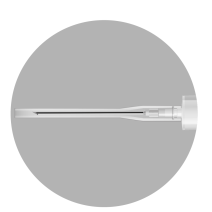
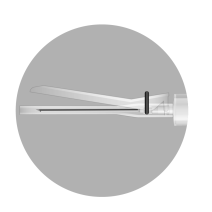
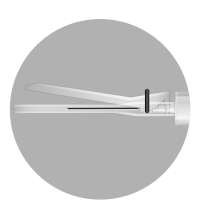
The presence of bubbles on the surface of the lyophilisate is a normal appearance of the product.
2a
|  |
2b
|  |
2c
|  |
2d
| 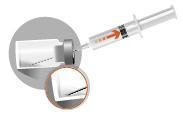 |
|  |
| Men, children: intramuscularly or only in men: subcutaneously |
 | |
| 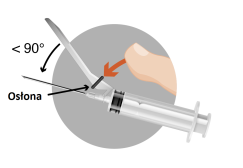 |
| Method A Method B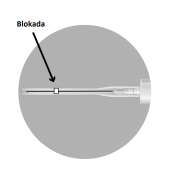 |
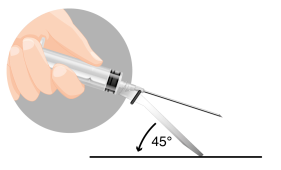
- Country of registration
- Active substance
- Prescription requiredYes
- Manufacturer
- ImporterIpsen Pharma Biotech SAS
- This information is for reference only and does not constitute medical advice. Always consult a licensed doctor before taking any medication. Oladoctor is not responsible for medical decisions based on this content.
- Alternatives to Diphereline Sr 11,25 mgDosage form: Solution, 0.1 mg/mlActive substance: triptorelinManufacturer: Ferring GmbHPrescription requiredDosage form: Powder, 3.75 mgActive substance: triptorelinManufacturer: Ferring GmbHPrescription requiredDosage form: Powder, 0.1 mgActive substance: triptorelinManufacturer: Ipsen Pharma Biotech SASPrescription required
Alternatives to Diphereline Sr 11,25 mg in other countries
The best alternatives with the same active ingredient and therapeutic effect.
Alternative to Diphereline Sr 11,25 mg in Ukraine
Alternative to Diphereline Sr 11,25 mg in Spain
Online doctors for Diphereline Sr 11,25 mg
Discuss dosage, side effects, interactions, contraindications, and prescription renewal for Diphereline Sr 11,25 mg – subject to medical assessment and local rules.











